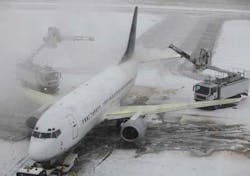Wastewater reed bed treatment takes off after Heathrow airport upgrade
Heathrow Airport has upgraded its wetland installation to process increased amounts of wastewater generated from the deicing of runways.
Waste streams generated from airports are typically from de-icing activities, aircraft wash down, fire fighting training and the terminals themselves. Airports have large areas of concrete and tarmac which collect rainwater which becomes contaminated as it mixes with fuel and glycol residues.
The original treatment wetlands at the airport were designed to remove deicers containing glycols using anaerobic processes with a design loading rate of 590kg BOD/d.
They were the right size for the volume of water but increased use of deicer over the past few years had overloaded the system therefore oxygen and nutrient availability were compromising treatment performance.
On occasion, effluent was tankered off-site for treatment which ARM Group said was "expensive and inefficient".
Treating glycol contaminated runoff is a challenge at every airport faced with varying cold-climate winter conditions. The runoff can contain over 20,000 mg COD/L at 1ºC.
Heathrow chose to upgrade its passive constructed wetland to the ARM Group’s innovative Forced Bed Aeration (FBA) system, which comprises a network of tubes bubbling air through the gravel to increase the oxygen availability of the existing system.
Oxygen-rich conditions are said to help degrade the glycols and acetates.
ARM has previously worked with Teeside, Belfast and Buffalo Niagra airports.
Tori Sellers, director of ARM Group, said: “Their challenge is keeping their runways open during increasingly harsh winters. That involves using higher concentrations of deicer which mixes with surface water run-off which then requires treating.”
###
Read more
Reed bed treatment set to branch out in Oman
Oman spreads its roots: reed bed water treatment plant to expand
About the Author

Tom Freyberg
Tom Freyberg is an experienced environmental journalist, having worked across a variety of business-to-business titles. Since joining Pennwell in 2010, he has been influential in developing international partnerships for the water brand and has overseen digital developments, including 360 degree video case studies. He has interviewed high level figures, including NYSE CEO’s and Environmental Ministers. A known figure in the global water industry, Tom has chaired and spoken at conferences around the world, from Helsinki, to London and Singapore. An English graduate from Exeter University, Tom completed his PMA journalism training in London.
